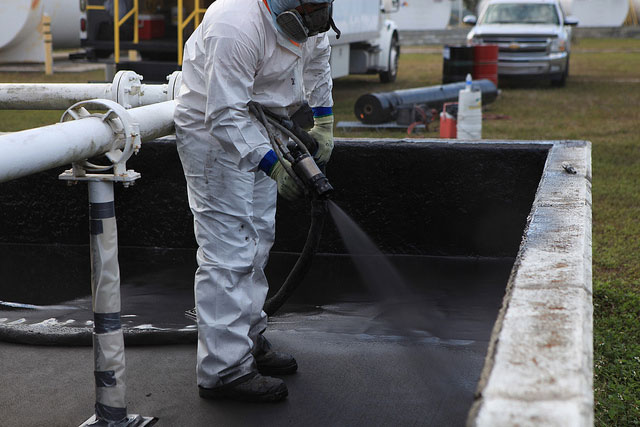
Traditional coatings have been too inflexible and not sufficiently elastic to accommodate ground, concrete, or metal substrate movement for primary or secondary containment. This deficiency can lead to cracks or holes forming in both the substrate and the coatings, which can compromise containment. However, the formulation of tough, monolithic, flexible coatings such as polyurea is now resolving this issue for contractors, engineers, and facility managers. When applied directly to concrete or metal surfaces, polyurea not only strengthens and protects lite underlying substrate but can also bridge gaps or cracks of 1/8″ or larger.

Furthermore, polyurea is now being applied to geotextile liners that can be swiftly rolled out in sheets to protect more heavily diminished surfaces or for use in field applications such as dirt or gravel pads at drilling sites. Once installed, applicators need only coat the liners’ seams to create a monolithic surface suitable for containment. Whether at refineries, industrial plants, or other manufacturing plants, regulations demand the use of primary and secondary containment systems to keep toxic or hazardous substances from escaping into the ground and potentially entering the water supply.

This implies primary containment is not foolproof. Though durable, metals corrode, concrete cracks, and is permeable, it will drain liquids if uncoated.
Therefore, secondary containment, in the form of concrete pits with barriers installed around the perimeter of a tank or other storage container, is often needed. To protect these structures, coatings such as epoxies, tars, and polyurethanes are often applied as an added protection wall. However, these traditional coatings are often inflexible when cured and can crack along with the concrete. Typical coatings do not hold up well to substrate movement or daily, seasonal, or process-related thermal expansion and contraction, which can lead to cracks and leaks.
After considerable research and testing, Collins says he turned to an advanced polyurea system from ArmorThane, a spray-applied polyurea manufacturer for primary and secondary containment. When applied to substrates such as concrete or steel, the spray-applied waterproof coating creates a durable, seamless, flexible, protective barrier that stops leaks and strengthens primary and secondary containment systems’ integrity. The coating exhibits superior physical properties such as hardness, tensile strength, and crack bridging and elongation up to 400% to create a robust, industrial-grade protective lining.
Polyurea can bridge cracks as well as flex at a rate similar to concrete and steel. This not only helps it last but also seals the concrete, so does Secondary containment, in the form of concrete pits tamers instated around the perimeter of a tank or other storage container, is often required as a back-up to primary containment does not absorb contaminants if there is a spill inside the contained area. While traditional coatings such as cementitious, epoxies, tars, and polyurethanes will prematurely fail if not installed under a relatively narrow range of temperatures, polyurea is designed for installation and use from ~4O°F to *35OCF. It sets and cures quickly and will withstand decades of freeze-thaw cycling and wide
After spraying the polyurea, return to service is almost instantaneous variations of temperature and humidity. After spraying the polyurea, return to service is almost instantaneous, making a big difference in minimizing production downtime.
They coated about 8,000 sq. ft. of concrete in 12 truck-offloading areas that required drive-in containment with ArmorThane polyurea. In some instances, trucks were safely driving across the concrete within minutes of spray application. Instead of spraying polyurea directly to the substrate, pre-sprayed composite panels can offer advantages for containment over soil, gravel, or even concrete that is too damaged to be effectively rehabilitated.
Repairing plastic liners also presents a problem at the seams, when damaged areas are cut out and new sections. Polyurea products are so much more durable than plastics for containment systems. When needed, they can custom apply more polyurea millage to geotextile panels and berms to accommodate even the heaviest truck use and vehicle abuse. To verify the strength of the polyurea coating on containment mats and berms, in fact, Collins conducted several tests.
They also ran 6,044 fully loaded water trucks across a containment system, and it withstood it with zero holes and no compromise to the liner. Collins credits both the durability of the ArmorThane polyurea and its extended recoating window for the ability of his company to reuse its containment systems extensively. To reuse a containment system, they cut it up into rolls, roll it up and move it. Then, take it back out, respond to certain areas, and reinstall the original containment system at another location. They’ve found the extended open window for recoat and repair of the polyurea allows them to cut out any damaged section of geotextile easily, put a new piece in, and spray the seams to make it virtually seamless again. They get better repair and more reuse out of our containment systems.

